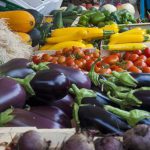The concept of eating seasonally is actually really simple. It involves eating foods that are grown at the same time as you want, or need, to eat them.
As most fruits and vegetables are being grown somewhere in the world at any one time, eating seasonally more specifically, concerns eating produce that’s being grown right now – locally.
One of the biggest advantages is the health benefits that eating seasonally can bring but the taste is so much better too which has huge bonuses for your diet.
Seasonal, local eating, includes eating fresh fruits and vegetables that haven’t been processed or transported long distances. Processing foods includes things such as tinning, blanching and dehydrating foods to enhance their life span.
Some food travels many miles to get to our shelves for 365 days a year. Out of season fruit and veg can spend days, even weeks travelling to get to you. This means they are picked earlier than they should be so that they are ready on arrival. In order to preserve foods that are out of season, these produce items are often covered in pesticides, waxes, and preservatives in order to maintain their fresh appearance.
Take oranges for example, they are:
- Bathed in chlorinated water.
- Washed with detergents.
- Sprayed with fungicide.
- Coated in wax for shine.
Clearly ripe fruits and vegetables contain the most nutrients, but the minute they are picked, their plant cells begin to shrink and their nutrients diminish.
Also, the longer produce sits on the shelves, the more nutrients and antioxidants they seem to lose. According to research from the University of California, Davis, spinach and green beans lose two-thirds of their vitamin C within a week of harvest. Pair this with long transportation times and sitting on the supermarket shelves and who knows how ‘nutrient dense’ your produce really is!
Eating freshly harvest produce tastes completely different! Remember the strawberries of your childhood? Oh, the sweetness! Or perhaps salad leaves which have a whole different crunchiness to those that have travelled further than most of us go in a year!
The other factor to consider though is the carbon footprint of our dinner table….
Rich Pirog of the Leopold Centre for Sustainable Agriculture reports that the average fresh food item, travels 1,500 miles to arrive on our dinner table. That’s a pretty large carbon footprint to leave for a little bulb of garlic.
Therefore, choosing to buy your food from local sources and when in season, eliminates the need for fuel-intensive transportation.
Also, wherever possible, try and select farmers who follow organic and sustainable farming practices, to minimise the environmental impact of your food. Farmers can only grow what the season will support.
Before transporting goods over long distances became commonplace, we had no option but to eat seasonally. As a result, we based our meal choices on the ingredients we had available. The natural cycle of produce is perfectly designed to support our health and so building a lifestyle around seasonal food, supports the body’s natural healing processes.
Leafy greens, abundant in spring, help our bodies *alkalize and detox after a winter of heavier foods. While in summer, water-dense fruits like berries, watermelons and cucumber keep us hydrated.
Nature, relatively left to its own devices, will provide us with what our body needs.
* treat with alkali.

